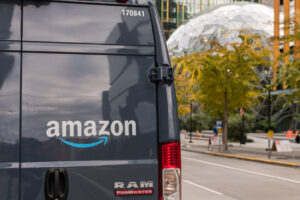AT&T and Verizon push back on 5G delay, communicators struggle to embrace AI, and CES pushes ahead with in-person event
Also: Planet Fitness launches campaign for start of the new year, banks delay return to office, and more.
Hello, communicators:
As January brings a renewed focus on health and well-being for consumers making new year’s resolutions, Planet Fitness announced that it will waive its enrollment fee for new members as part of its “Feel Fitacular” messaging campaign. The campaign also emphasizes the need to maintain physical and mental health going into 2022 and cites the CDC’s recommendations for exercise alongside each gym’s COVID-19 safety and sanitation protocols.
https://www.youtube.com/watch?v=SC1gmiyQFCU
“In 2022, we’re encouraging everyone to make exercise a priority and come to Planet Fitness to start their fitness journey with us,” Planet Fitness CMO Jeremy Tucker said in a press release. “This means putting your physical and mental health first and experiencing all that the Judgement Free Zone has to offer. Fitness is essential to our overall well-being and an activity that everyone can benefit from right now.”
This campaign demonstrates how your message should be timely with seasonal references and offer meaningful expert sources, such as the CDC, alongside popular topics of national conversation like mental health and well-being.
Here are today’s top stories:
AT&T and Verizon reject FAA’s request to delay 5G launch
AT&T and Verizon wrote a letter to the Federal Aviation Agency (FAA) denying the agency’s request that the telecom giants further delay the rollout of their expanded 5G networks. The FAA’s latest request asked the mobile carriers to delay their launch by no more than two weeks, expanding on the carriers’ previous promise to delay the 5G rollout by one month.
As a compromise, the carriers voluntarily proposed to reduce the strength of their 5G signals for six months to match a similar policy adopted in France.
According to the letter, shared by The Wall Street Journal:
As you know, U.S. aircraft currently fly in and out of France every day with thousands of U.S. passengers and with the full approval of the FAA. As a result, France provides a real-world example of an operating environment where 5G and aviation safety already co-exist. The laws of physics are the same in the United States and France.
We care deeply about the safety of our customers, employees, and families, all of whom fly domestically and internationally for business and pleasure. Our two companies are deeply committed to public safety and national security, and fortunately, the question of whether 5G operations can safely coexist with aviation has long been settled.
What it means:
Arriving amid a travel season disrupted by thousands of flight cancelations due to inclement weather and COVID-19, the timing of FAA’s request to AT&T and Verizon has been publicly questioned by the telecom companies, which claim the aerospace industry is holding 5G airwaves “hostage” to get the carriers to pick up the bill to improve old airline hardware.
While both sides continue to wage a media war to try and persuade Americans, the technical details of the argument aren’t likely to resonate with a wide audience. As airlines and airports continue to stress safety, the telecom companies will have more work ahead as they try to convince travelers that the new 5G technology poses no real threat.
MEASURED THOUGHTS
A new study by The Chartered Institute of Public Relations (CIPR) found that 43% of PR pros feel less confident and have limited knowledge of how they can use artificial intelligence (AI) in their work. Only 8% feel very comfortable using A.I. in their role, compared to 21% that feel very comfortable using data and analytics.
“There is clearly a willingness to learn and adapt—but knowing where to start and a lack of time, training and skills seems to be putting a brake on progress,” said CIPR’s Andrew Bruce Smith. “However, doing nothing is not an option either. AI is already impacting every aspect of PR from strategic planning to writing content.
Check out the full study here.
TAKE OUR SURVEY
If you’re looking to further your understanding of your industry to navigate what’s ahead in 2022, lend us a hand—and help yourself and your peers identify shared benchmarks in areas such as budgets, team structure, ESG and DE&I efforts, and more. Participate in Ragan Communications Leadership Council’s 2022 Benchmark Survey, a comprehensive look at how to negotiate budgets with your executives, how to best reach deskless workers and foster culture among a hybrid workforce, and more.
Both internal and external communicators are encouraged to participate.
By taking part, you’ll be entered to win one of three $100 gift cards. All who complete the survey will receive a full report on the findings. Responses are anonymous.
Survey takers will receive an executive summary of the findings.
THE WORKPLACE
Several big financial institutions, including CitiGroup and JPMorgan Chase, wrote memos to employees announcing that they will delay a return to the office amid rising cases of omicron variant of COVID-19.
“We will continue to monitor the data and provide an update in January on when we expect to be back in the office in a similar manner as we have been,” Citi said in the memo.
“Across the US we are seeing a rapid rise in Covid-19 cases related to the Omicron variant,” JPMorgan said in the memo. “With the increase in holiday travel and gatherings, we are allowing for more flexibility during the first two weeks of January.”
JPMorgan stressed that it is “not changing our long-term plans of working in the office” — and employees will be due back soon. “We expect everyone to return to their in-office schedule no later than February 1,” the memo said.
These memos are just a sample of how many large corporations are tempering their optimism for a return to the office with changing news and data. In line with the way that both financial institutions operate, these messages demonstrate how your messaging can also deploy data as a means for communicating delayed office returns without making room for political or social conjecture and assure your workforce by offering a timeline for next steps.
Announcing the PR Daily Leadership Network
PR Daily is launching the PR Daily Leadership Network, a unique membership group from Ragan Communications offering peer-to-peer advisory and team training along with a unique slate of resources and events to help public relations professionals break through the noise, increase their visibility and forge meaningful connections.
The Network provides daily insights and coverage on a range of topics including media relations, social media, measurement, Diversity, Equity & Inclusion, branding, thought leadership and crisis communications.
“The fast pace of change coupled with the demand on public relations professionals to protect and sometimes defend their company’s reputation make it imperative for leaders to tap into the wisdom of other communicators and continue to learn and grow,” says Diane Schwartz, CEO of Ragan Communications. “The PR Daily Leadership Network provides the answers but also encourages members to question the status quo and push for positive change.”
Visit leadership.prdaily.com to learn more.
Consumer Electronics Show explains health measures for in-person event
The world’s biggest tech trade show, the Consumer Electronics Show (CES), will take place in-person this week with 2,200+ exhibitors despite cancelations from some of the industry’s biggest names including Microsoft and Google. As a preventative measure, the show will be shortened to three days.
In a statement about the decision to continue hosting its event, CES outlined its health and safety policies that include attendees providing proof of vaccination to pick up their show badges along with proof of a negative COVID-19 test less than 24 hours before entering a CES venue, masks during the show and a PCR test before flying home.
According to its press release:
“As the world’s most influential technology event, CES is steadfast in its pledge to be the gathering place to showcase products and discuss ideas that will ultimately make our lives better,” said Gary Shapiro, president and CEO, CTA. “We are shortening the show to three days and have put in place comprehensive health measures for the safety of all attendees and participants.”
Why it matters:
CES’ decision to proceed with its in-person show demonstrates what critics of the decision (like tech news site Gizmodo) describe as “a reflection of the intense clash between business and health.”
While Shapiro’s statement ties the mission of CES to improving lives through consumer technology, this idea is buried in the press release under a headline touting the show’s 2,200+ in-person exhibitors. When crafting crisis messaging around a decision that can be perceived as controversial, don’t bury the lede—and make sure concern for stakeholders is prioritized over messages about profits and commercial success.







